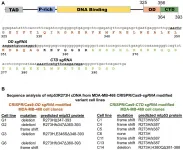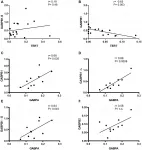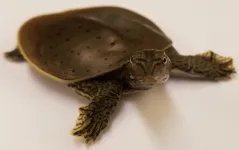(Press-News.org) Citrus fruits from the mandarin family have important commercial value but how their diversity arose has been something of a mystery
Researchers analyzed the genomes of the East Asian varieties and found a second center of diversity in the Ryukyu Islands along with the previously known center in the mountains of southern China
They discovered a new citrus species native to Okinawa that arose about two million years ago when the Ryukyu archipelago became disconnected from mainland Asia
Other citrus from Okinawa and mainland Japan, including shiikuwasha and tachibana, are hybrids of this newly discovered wild species with different mainland Asian varieties
This research may have commercial implications and opens the potential to create additional hybrids with favorable traits
Citrus fruits from the mandarin family are popular throughout the world for their tasty and healthy characteristics. Within Japan, the tiny shiikuwasha and the ornamental tachibana are of special cultural and historical importance. However, the origin of these two varieties, and other East Asian citrus, was always something of a mystery, until now.
In a new study, published in Nature Communications, scientists from the Okinawa Institute of Science and Technology Graduate University (OIST), and collaborators from other institutes, analyzed 69 genomes from the East Asian mandarin family, alongside their mainland Asian relatives, to reveal a far-ranging story of isolation, long-distance travel, and hybridization.
The story starts in the Hunan Province of southern China, which is the center of wild mandarin diversity and the genetic source of most well-known mandarins. When the scientists re-analyzed previously published genomic data, they unexpectedly found that wild mandarins of this mountainous region are split into two subspecies.
"We found that one of these mandarin subspecies can produce offspring that are genetically identical to the mother," said Dr. Guohong Albert Wu, a research collaborator at the Lawrence Berkeley National Laboratory in California. "Like many other plants, wild citrus typically reproduces when the pollen of the father combines with the egg of the mother, mixing the genes from both parents in the seed. But we found a subspecies of wild mandarins from Mangshan, in southern China, where the seed contains an identical copy of the mother's DNA without any input from a father. So, the seed grows to be a clone of the mother tree."
Back in Okinawa, the researchers looked more carefully at a strange shiikuwasha-like citrus that produces small, acidic fruit and had been ignored by local farmers since it has little commercial value. To their surprise, they found that this strange citrus represented a previously undescribed species, which they named the Ryukyu mandarin or, more formally, Citrus ryukyuensis. And in contrast to the well-known shiikuwasha, which reproduces clonally (like the subspecies in Mangshan), the new species always reproduces sexually.
Remarkably, the researchers found that all shiikuwasha are hybrids of a very specific type--one parent is from the local Ryukyuan species and the other, from mainland Asia. Surprisingly, all shiikuwasha have the same mainland mandarin parent, meaning that all shiikuwasha are half-siblings.
They concluded that tens of thousands of years ago a mainland Asian mandarin was transported, either by people or by natural methods, to the land that would become the Ryukyu Islands. There it mated with the native Ryukyu citrus. The researchers traced the ancestry of this mainland Asian mandarin back to Mangshan, where it acquired its ability to reproduce asexually. This ability was passed on to its children.
Thus, all the shiikuwasha varieties found in Okinawa's markets today are descended from this mating, and reproduce asexually, allowing stable varieties like golden shiikuwasha to be propagated from generation to generation.
And what of tachibana and the other East Asian mandarin variations?
"They're all hybrids!" explained Dr. Chikatoshi Sugimoto, Postdoctoral Scholar in OIST's Molecular Genetics Unit. "The tachibana lineage also seems to have descended from the newly described Ryukyu species and another mandarin from China, but its birthplace was probably what is now mainland Japan."
Once they saw the genetic pattern in shiikuwasha and tachibana, the researchers also recognized another half-sibling family comprising various traditional Ryukyuan types--oto, kabuchii, tarogayo, and other unnamed citrus. This family, which the researchers called 'yukunibu' (sour citrus in the native Okinawan language), is much younger than shiikuwasha and tachibana. It arose when the famous kunenbo--also the father of satsuma mandarins--hybridized with the native Ryukyu mandarin. Kunenbo was brought to Okinawa from Indochina around 4-500 years ago by maritime trade. Like the mainland parents of shiikuwasha and tachibana, it was also able to clone itself by seeds, due to its distant Mangshan ancestry, and it passed this trait on to its children.
"It's fascinating to puzzle out the story of mandarin diversification and its relationship to the biogeography of the region," concluded Prof. Dan Rokhsar, Principal Investigator of OIST's Molecular Genetics Unit. "But it also could have commercial value. What other possibly hybrid types are there? Could we create new hybrids that are more resilient to disease or drought, or have other desirable characteristics? By looking into the past, we can create all sorts of possibilities for the future."
INFORMATION:
To unravel this diversity, the researchers worked closely with industry and individuals in Okinawa, including Okinawa Prefectural Agricultural Research Center, Nago Branch, Katsuyama Shiikuwasha, and local farmer, Hiroshi Kobashigawa.
Canada should anticipate a resurgence of a childhood respiratory virus as COVID-19 physical distancing measures are relaxed, authors warn in CMAJ (Canadian Medical Association Journal).
Cases of respiratory syncytial virus (RSV) have risen sharply in Australia and, more recently, the United States as COVID-19 case counts have waned and pandemic public health measures have been relaxed. Respiratory syncytial virus affects the lower respiratory tract and can cause serious illness and death. Before the COVID-19 pandemic, about 2.7 million children worldwide were infected with RSV each year, and it was the fourth most common cause of death in young children.
"The off-season resurgence in seasonal respiratory viruses now potentially poses a threat to vulnerable infants," ...
A new "return to campus" survey led by The Ohio State University's Office of the Chief Wellness Officer finds rising rates of anxiety, depression, burnout and the use of unhealthy coping mechanisms among students navigating through a year affected by the COVID-19 pandemic, similar to other data on college students throughout the U.S.
Ohio State conducted surveys in August 2020 and April 2021 of randomly-selected students to assess changes in mental health, coping strategies, healthy lifestyle behaviors and needs over time. Among the 1,072 Ohio State students who responded:
Students who screened positive for anxiety:
August 2020: 39%
April 2021: 42.6%
Students who screened positive for depression:
August 2020: 24.1%
April 2021: 28.3%
Students who screened ...
PITTSBURGH, July 26, 2021 - Adolescents who set goals for their future and those with strong parental support are less likely to use e-cigarettes and other tobacco products, according to a study by UPMC Children's Hospital of Pittsburgh and University of Pittsburgh School of Medicine physician-scientists.
The research, published today in the journal Pediatrics, suggests that strategies to prevent youth vaping may be different from what works to dissuade youth from smoking cigarettes.
"The use of e-cigarettes by young people is at epidemic proportions, with 27% of youth ...
Survival rates for adolescents and young adults diagnosed with cancer have varied considerably depending on cancer type. A new study indicates that survival for multiple cancer types in such patients has improved in recent years, but some patients diagnosed with common cancer types still show limited survival improvements. The results are published by Wiley early online in CANCER, a peer-reviewed journal of the American Cancer Society.
For the study, investigators at the National Cancer Institute analyzed survival trends related to cancers with the highest mortality rates in adolescents and young adults. Relying on information from the Surveillance, Epidemiology, and End Results (SEER) cancer ...
Oncotarget published "Frame-shift mediated reduction of gain-of-function p53 R273H and deletion of the R273H C-terminus in breast cancer cells result in replication-stress sensitivity" which reported that these authors recently documented that gain-of-function mutant p53 R273H in triple negative breast cancer cells interacts with replicating DNA and PARP1. The missense R273H GOF mtp53 has a mutated central DNA binding domain that renders it unable to bind specifically to DNA, but maintains the capacity to interact tightly with chromatin.
Both the C-terminal domain ...
Oncotarget published "TERT and its binding protein: overexpression of GABPA/B in high grade gliomas" which reported that all GA-binding proteins progress through the glioma grades and have the highest expression levels in secondary glioblastomas.
In secondary glioblastomas after chemotherapy, GABPB1 and GABPB1-L are expressed on a lower level than without treatment.
Between primary and secondary glioblastomas with and without chemotherapy, TERT is elevated in the former while GABPB1 is increased in the secondary glioblastomas.
GABPA and GABPB1, GABPB1-L and GABPB1-S positively correlate in primary glioblastomas.
This ...
Thermal-imaging sensors that detect and capture images of the heat signatures of human bodies and other objects have recently sprung into use in thermostats to check facial temperatures in a contactless attempt to screen for COVID-19 at several building entrances. Under these circumstances, the smartphone industry is actively considering the incorporation of such sensors as portable features to create the add-on function of measuring temperature in real time. Additionally, the application of such technology to autonomous vehicles may facilitate safer autonomous driving.
A research team lead by Dr. ...
The feeling of a needle piercing skin is familiar to most people, especially recently as COVID-19 vaccinations gain momentum. But what exactly happens when a needle punctures skin? The answer is revealed in a new paper published recently in the Journal of the Mechanics and Physics of Solids. ...
Even in the absence of bark beetle outbreaks and wildfire, trees in Colorado subalpine forests are dying at increasing rates from warmer and drier summer conditions, found recent University of Colorado Boulder research.
The study, published in the May print issue of the Journal of Ecology, also found that this trend is increasing. In fact, tree mortality in subalpine Colorado forests not affected by fire or bark beetle outbreaks in the last decade has more than tripled since the 1980s.
"We have bark beetle outbreaks and wildfires that cause very obvious mortality of trees in Colorado. But we're showing that even in the areas that people go hiking in and where the forest looks healthy, mortality is increasing ...
AMES, Iowa - A new study led by an Iowa State University scientist sheds light on how organisms have evolved to address imbalances in sex chromosomes.
The study looks at a species of softshell turtle, but the results could help to illuminate an important evolutionary process in many species, said Nicole Valenzuela, professor of ecology, evolution and organismal biology and lead author of the study.
Many organisms determine their sex by a pair of specialized chromosomes that appear in virtually every cell of an organism's body. A matched pair of chromosomes results in one sex, while a mismatched pair results in another sex. For instance, in humans and many other species, sex chromosomes are referred to as X and Y. Typically, two X chromosomes ...






